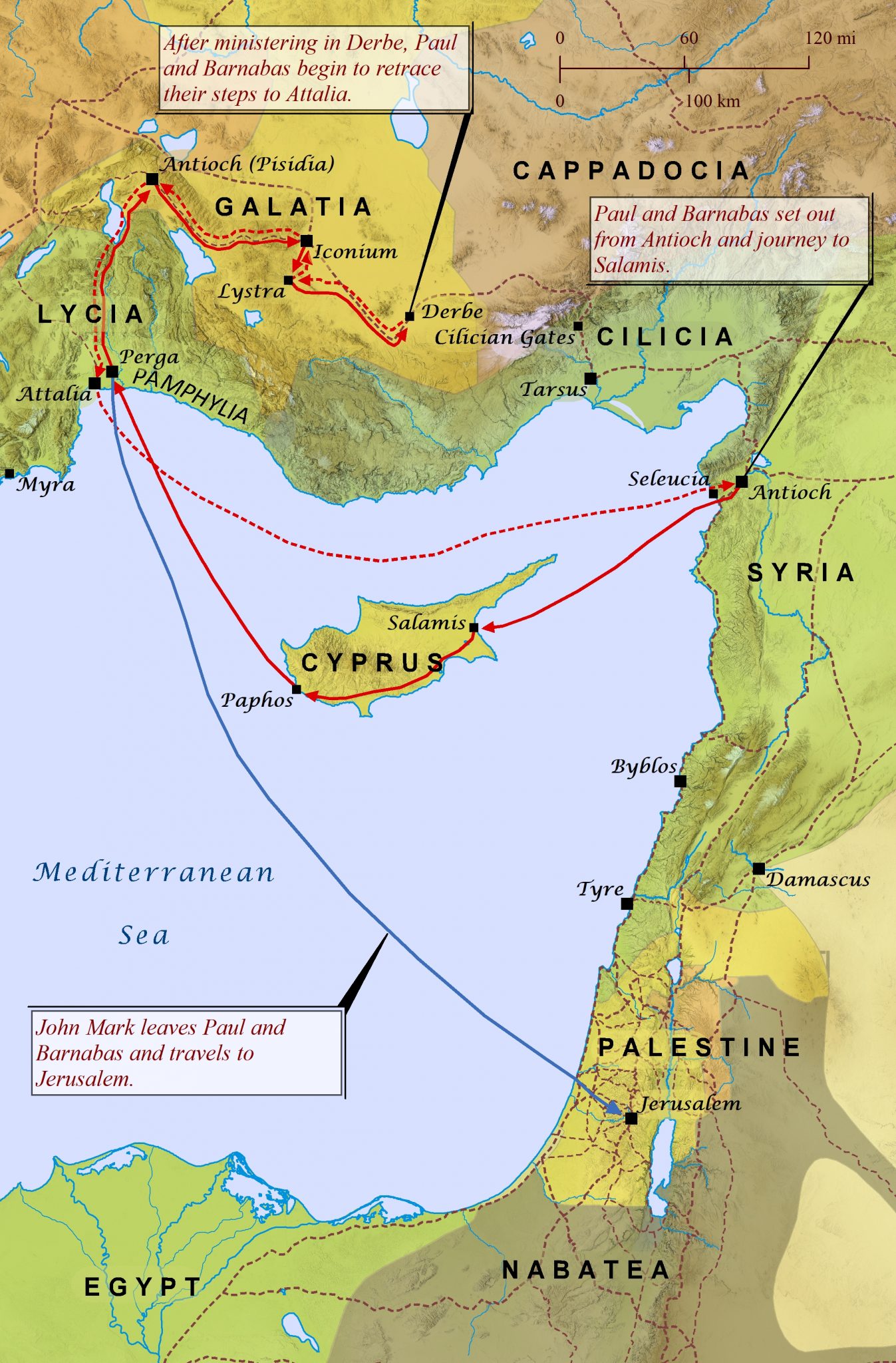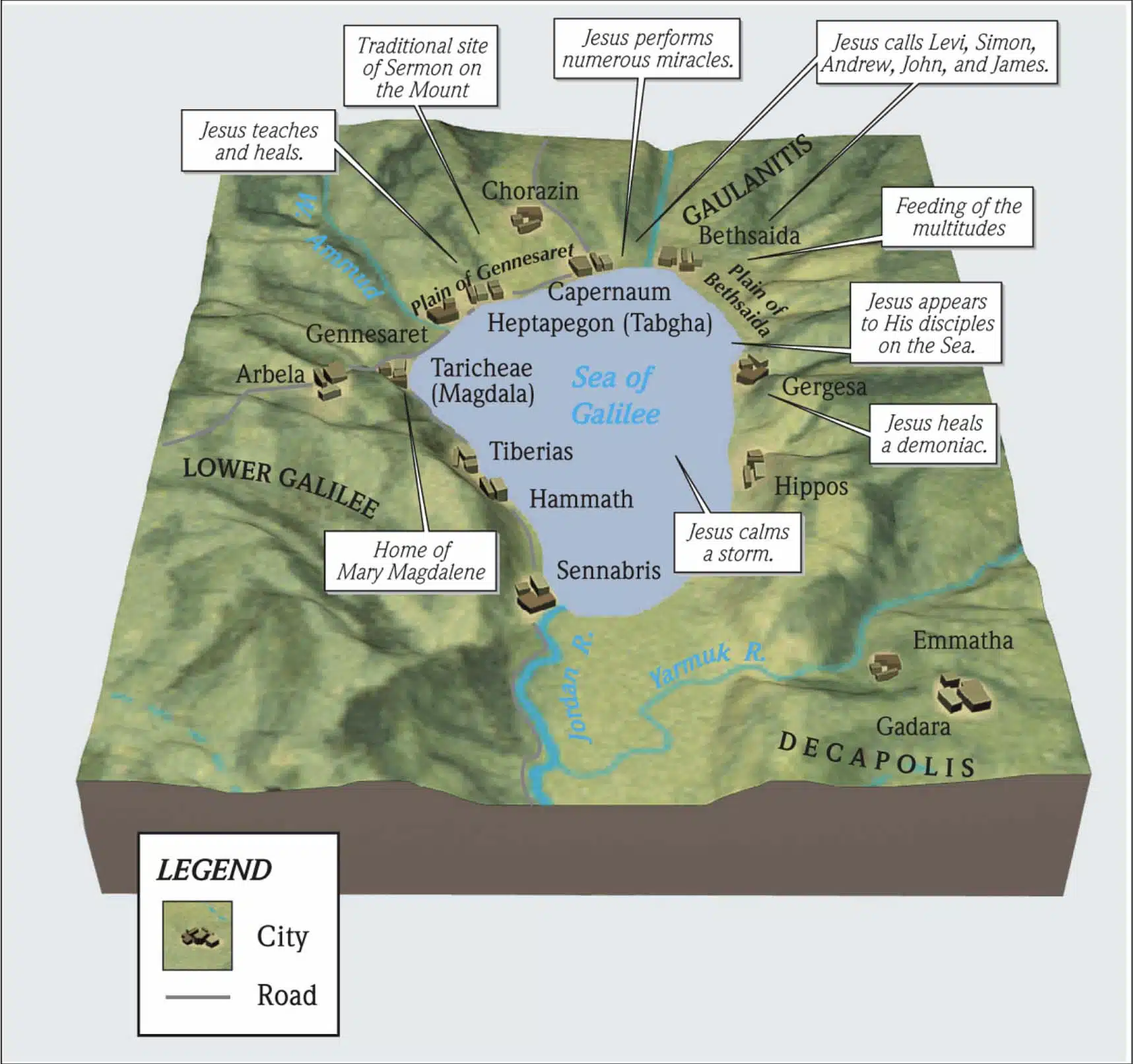Paul tells his audience that Jesus was the promised Savior sent by God. He fulfilled the prophecies and promises made by God in the Old Testament. The leaders of Israel rejected Jesus and put Him to death, which was also prophesied in the Old Testament. God raised Jesus back to life. Many witnesses saw Jesus after He resurrected and have been spreading the news ever since.
Luke’s record of Paul’s synagogue sermon in Pisidian Antioch continues. Paul extends familiarity and common cause to his audience by calling them Brethren. He is displaying that they have common ancestry and purpose as Jews, Brethren, that they are all sons of Abraham’s family (v. 26). To the Gentiles in the audience who had converted to Judaism, Paul acknowledges them as those among you who fear God. The men listening to his message would understand all that he had said so far.
Paul had begun his sermon by tracing God’s work in calling Abraham and the other patriarchs, to leading the Israelites out of slavery in Egypt, conquering the land of Canaan for them and portioning it to them, leading them through judges, then through kings, first Saul, then David, who was a man after God’s own heart, to whom God had promised to make one of his heirs a king forever over Israel.
This heir of David was Jesus, Paul has explained, and John the Baptizer had preached of His coming and His greatness, calling all of Israel to turn from its sins and identify themselves with the coming King and Savior.
In verse 23, Paul revealed that Jesus is God’s sent Savior. Here he begins to explain to these Jewish brethren and Gentiles who fear God how God worked through Jesus the Savior. Paul tells them why he and Barnabas have travelled all the way from Jerusalem and Antioch to talk to them in their synagogue in Galatia: to us the message of this salvation has been sent (v. 26).
The message was sent to Paul and Barnabas so that they would tell it to the world (Acts 13:2, 26:16-18), the message of Jesus the Savior and the salvation He brings. The Greek word translated salvation is “soteria.” It means to be delivered from something to something.
Having set the stage, Paul now begins the message of this salvation. He summarizes who Jesus was and what He accomplished, and those who opposed Him.
In contrast to John the Baptizer, who recognized Jesus as the Savior, the leaders of Israel did not recognize Him:
For those who live in Jerusalem, and their rulers, recognizing neither Him nor the utterances of the prophets which are read every Sabbath, fulfilled these by condemning Him (v. 27).
Paul is referencing how crowds of those who live in Jerusalem and their rulers, the priests (known as Sadducees) and the teachers of the Law (known as Pharisees) condemned Jesus to death. The crowds, the Sadducees, and the Pharisees rejected Jesus as the Messiah and called for His crucifixion (Matthew 27:20-23).
The Jewish people and their rulers recognized neither Jesus as the Messiah nor the utterances of the prophets which are read every Sabbath, the many prophecies throughout the Old Testament which Jesus fulfilled. Though for centuries upon centuries God had been telling the Jewish people about their Messiah, they failed to recognize Him when He finally came. Thus those who rejected Jesus themselves fulfilled the prophecies by condemning Him to death (Isaiah 53:3-9, Psalm 118:22-23).
And though they found no ground for putting Him to death, they asked Pilate that He be executed (v. 28).
Jesus lived a sinless life. There was no ground for arresting Him, for trying Him, and for putting Him to death. (For more, read our articles on Jesus’s Trial).
In fact, the Roman governor Pilate declared Jesus innocent numerous times, and tried many ways to release Jesus without causing a riot among the assembled mob. The Pharisees and Sadducees had to all but beg the Roman governor Pilate to see that He be executed, demanding it of him and accusing him of treason to Rome, “If you release this Man [Jesus], you are no friend of Caesar; everyone who makes himself out to be a king opposes Caesar” (John 19:12). So Pilate yielded.
Paul continues:
When they had carried out all that was written concerning Him, they took Him down from the cross and laid Him in a tomb (v. 29).
The phrase all that was written concerning Him references all the prophecies about how the Messiah would suffer (Isaiah 53:7, Isaiah 50:6, Isaiah 53:12, Psalm 69:21, Psalm 22:16, Zechariah 12:10, Psalm 34:20, Psalm 22:1, Psalm 109:4, Zechariah 12:10).
After every prophecy was fulfilled and Jesus died, they took him down from the cross and buried Him in a tomb. Paul does not specify here, but Jesus’s burial was carried out by a wealthy believer in Jesus, Joseph of Arimathea, a righteous Pharisee who secretly believed Jesus was the Messiah and followed His teachings. Joseph of Arimathea prepared Jesus’s body with an expensive amount of spices and laid him in a garden grave plot, possibly reserved for Joseph’s own eventual death (Matthew 27:57, John 19:38-42, Luke 23:50-56). This too carried out a prophecy that was written concerning the Messiah, that He would be buried among the rich, rather than among criminals:
“His grave was assigned with wicked men,
Yet He was with a rich man in His death,
Because He had done no violence,
Nor was there any deceit in His mouth.”
(Isaiah 53:9)
Paul’s point here is that Jesus died according to what Scripture said would happen to God’s Messiah. Over and over, Paul is emphasizing how Jesus fulfilled the Scriptures, He lived out the prophecies, thus showing that He is the genuine, undeniable Messiah of God.
Then Paul shares the most important piece of the gospel message. Until now, his audience was probably listening with great interest, yet with some familiarity of what he spoke of; it was not impossible that they had heard of Jesus’s miracles in Judea and Galilee over a decade ago in the motherland of Israel, and how he was executed by the Romans. But what Paul says next may have shocked them:
But God raised Him from the dead (v. 30).
Jesus did not remain dead. God resurrected Him. Once more, Paul points to God as the grand designer and intervener behind all the events of the Old Testament, the prophecies, and Jesus’s resurrection. It was God who raised Jesus back to life.
Rather than leaving it at that single declarative statement, Paul provides evidence of the resurrection by explaining that Jesus was seen by and interacted with many people after God raised Him from the dead. These people were still living at the time of Paul’s sermon. This all happened relatively recently, less than twenty years prior, and there are hundreds of people who saw that Jesus was raised from the dead and came back to life:
and for many days He appeared to those who came up with Him from Galilee to Jerusalem, the very ones who are now His witnesses to the people (v. 31).
For many days, forty in total, Jesus appeared to His disciples who had travelled with Him from the northern province of Galilee to the capital city of Jerusalem. Paul categorizes these disciples as the very ones who are now His witnesses to the people, probably thinking of Peter and the other apostles in Jerusalem, and Mary Magdalene (John 20:14-16), as well as the hundreds of other disciples who followed Jesus in His ministry.
Years later, in a letter to the Corinthian believers, Paul will cite the fact that five hundred people interacted with Jesus after He resurrected,
“After that He appeared to more than five hundred brethren at one time, most of whom remain until now, but some have fallen asleep.”
(1 Corinthians 15:6)
These people are witnesses of His resurrection, and have been telling the world that their Messiah lives ever since, as He commanded them to (Matthew 28:16–20).
Biblical Text
26 “Brethren, sons of Abraham’s family, and those among you who fear God, to us the message of this salvation has been sent. 27 For those who live in Jerusalem, and their rulers, recognizing neither Him nor the utterances of the prophets which are read every Sabbath, fulfilled these by condemning Him. 28 And though they found no ground for putting Him to death, they asked Pilate that He be executed. 29 When they had carried out all that was written concerning Him, they took Him down from the cross and laid Him in a tomb. 30 But God raised Him from the dead; 31 and for many days He appeared to those who came up with Him from Galilee to Jerusalem, the very ones who are now His witnesses to the people.
Check out our other commentaries:
-
Matthew 5:1-2 meaning
After observing the large crowds, Jesus withdraws to a mountainside and His disciples follow Him. Jesus then begins to teach His disciples. What follows in...... -
Colossians 2:6-8 meaning
Paul encourages the believers to remember and stand firm in their established faith. The deceptions of the world can easily distract us from the true...... -
Revelation 2:10 meaning
Jesus encourages the Smyrna believers to be courageous in the face of their coming trial. They will be imprisoned, and it will test their faith,...... -
Deuteronomy 31:1-6 meaning
Moses addressed all Israel to tell them that his time leading them was coming to an end and that Joshua would succeed him and lead...... -
Deuteronomy 14:9-10 meaning
Moses gives regulations regarding aquatic animals that were acceptable and unacceptable for food. Any fish that has fins and scales is permitted. Any fish that......




